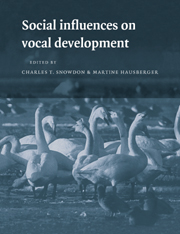Book contents
- Frontmatter
- Contents
- List of contributor
- 1 Introduction
- 2 Social interaction and sensitive phases for song learning: A critical review
- 3 Social interaction and vocal development in birds
- 4 Building a social agenda for the study of bird song
- 5 Field observations, experimental design, and the time and place of learning bird songs
- 6 Vocal learning in wild and domesticated zebra finches: Signature cues for kin recognition or epiphenomena?
- 7 What birds with complex social relationships can tell us about vocal learning: Vocal sharing in avian groups
- 8 Social influences on song acquisition and sharing in the European starling (Sturnus vulgaris)
- 9 Social influences on the acquisition of human-based codes in parrots and nonhuman primates
- 10 Vocal learning in captive bottlenose dolphins: A comparison with humans and nonhuman animals
- 11 Vocal learning in cetaceans
- 12 Social influences on vocal development in New World primates
- 13 Some general features of vocal development in nonhuman primates
- 14 Social influences on vocal learning in human and nonhuman primates
- 15 The resilience of language in humans
- 16 Reciprocal interactions and the development of communication and language between parents and children
- 17 Crafting activities: Building social organization through language in girls' and boys' groups
- Index
5 - Field observations, experimental design, and the time and place of learning bird songs
Published online by Cambridge University Press: 04 August 2010
- Frontmatter
- Contents
- List of contributor
- 1 Introduction
- 2 Social interaction and sensitive phases for song learning: A critical review
- 3 Social interaction and vocal development in birds
- 4 Building a social agenda for the study of bird song
- 5 Field observations, experimental design, and the time and place of learning bird songs
- 6 Vocal learning in wild and domesticated zebra finches: Signature cues for kin recognition or epiphenomena?
- 7 What birds with complex social relationships can tell us about vocal learning: Vocal sharing in avian groups
- 8 Social influences on song acquisition and sharing in the European starling (Sturnus vulgaris)
- 9 Social influences on the acquisition of human-based codes in parrots and nonhuman primates
- 10 Vocal learning in captive bottlenose dolphins: A comparison with humans and nonhuman animals
- 11 Vocal learning in cetaceans
- 12 Social influences on vocal development in New World primates
- 13 Some general features of vocal development in nonhuman primates
- 14 Social influences on vocal learning in human and nonhuman primates
- 15 The resilience of language in humans
- 16 Reciprocal interactions and the development of communication and language between parents and children
- 17 Crafting activities: Building social organization through language in girls' and boys' groups
- Index
Summary
INTRODUCTION
Songbirds learn their songs by hearing others and then copying them, matching or improvising on the song theme (Slater 1989; Catchpole & Slater 1995). Their social behavior varies among species – they are migratory or resident, solitary or group-living, faithful partners to a single mate, polygynous or with no pair bond, and parental or nonparental in the care of their offspring (brood parasites lay in nests of other species, and their fosterers rear the young). All songbirds depend on parental care, and it has been suggested that this is the time when the young learn their songs. Later, when they are independent, the birds engage in a wider range of social interactions.
Field studies suggest that most songbirds learn their songs after the time of natal dispersal, when a bird moves from the site where it was reared to an area where it copies the song of a neighbor, rather than singing the song of its father: Bewick's wrens (Thryomanes bemickii), marsh wrens (Cistothorus palustris), saddlebacks (Philesturnus carunculatus), indigo buntings (Passerina cyanea), white-crowned sparrows (Zonotrichia leucophrys), and corn buntings (Emberiza calandra) (Kroodsma 1974; Verner 1976; Jenkins 1978; Payne et al. 1987; Baptista & Morton 1988; Petrinovich 1988; McGregor & Thompson 1988; McGregor et al. 1988). Song sparrows (Melospiza melodia) copy at least one song from three or four neighboring males when they settle on a territory, some time after the first four weeks of life (Nice 1943; Beecher et al. 1994). In two species males often copy their father (Darwin's finches (Geospiza fortis), zebra finches (Taeniopygia guttata); Millington & Price 1985; Gibbs 1990; Zann 1990), but not all individuals do this.
- Type
- Chapter
- Information
- Social Influences on Vocal Development , pp. 57 - 84Publisher: Cambridge University PressPrint publication year: 1997
- 25
- Cited by

